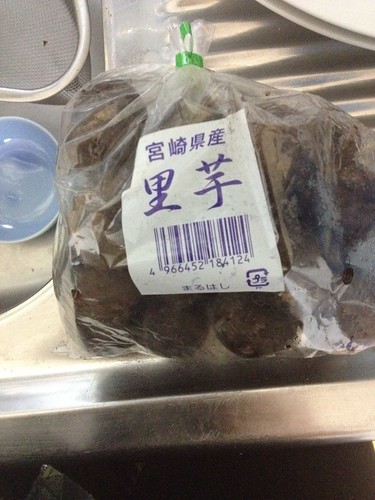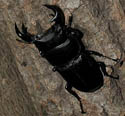|
Grand Fromage posted:What's the shelf life on flower peppers? I used some tonight and didn't get much of a numb off them, not sure if they're old or I just didn't use enough. I used maybe a teaspoon in gravity's yuxiang rousi recipe. Picked out the black seeds, toasted a bit in the pan and then crushed up with a spoon and mixed into the sauce. This may sound dumb, but are you sure you have the correct peppercorns? I accidentally bought peking peppercorns once because of how similar they look and they do not have the numbing effect. My guess if your dish was slimy is that you used too much cornstarch and/or oil. Oil won't make something slimy on its own but I can imagine cornstarch doing funky things if there is too much oil. Also, if you are in America, I hear there are import restrictions that require the peppercorns be treated in such a way that seriously limits their numbing quality. pogothemonkey0 fucked around with this message at 03:37 on Oct 10, 2012 |
|
|
|

|
| # ? Apr 29, 2024 12:17 |
|
Grand Fromage posted:It was good but a little slimy? I'm not sure how to describe it exactly. The sauce was very thick and clung to the food, no extra liquid, but it felt like something was off. My guesses were too much oil, too much cornstarch, or too much sugar. The starch and sugar were exact, oil I didn't measure but was generous. Tasted good but I think I did something wrong. It sounds like you added too much slurry. You really only need to add enough to give the liquid body, you don't want it to be all slimy.
|
|
|
|
They are the right ones. A few bites were numbing but it wasn't very strong or consistent. I'm suspecting too much oil too, will try again with less. E: I'll try cutting cornstarch too. Should I take it out of the marinade or reduce what's in the sauce? I don't know what it does in the marinade. My marinade was the suggested one for the half pound. If anything I had a bit more meat than that, it was dry to the point I was worried but seemed to be okay. Grand Fromage fucked around with this message at 04:52 on Oct 10, 2012 |
|
|
|
So I bought a thing today and I'm hoping a kind goon can confirm for me if I purchased the right thing. Making Mapo Tofu is pretty high on my agenda this weekend and I was trying to avoid just buying an instant sauce packet I grabbed what I hope is proper Sechuan chili bean paste. The ingredients list is broad bean, chili, flour and salt.  ninja edit: I just realised that the last of the fermented black beans have been used. 
|
|
|
|
pseudomonkey posted:So I bought a thing today and I'm hoping a kind goon can confirm for me if I purchased the right thing. Making Mapo Tofu is pretty high on my agenda this weekend and I was trying to avoid just buying an instant sauce packet I grabbed what I hope is proper Sechuan chili bean paste. EDIT: by the way, it is spelled 'Sichuan.' Ghost of Reagan Past fucked around with this message at 17:09 on Oct 10, 2012 |
|
|
|
I was experimenting with various small batches of sauces, trying to make my own to perfect by mixing various ingredients, and I ended up with a wonderful take-out style sauce perfect for those like me; people who are always reading this thread but afraid to start using the more esoteric ingredients because what the gently caress who eats duck eggs buried in the ground for a million years. It uses the spicy chili crisp, oyster sauce, fermented black bean (how is this stuff sooooo good?), chili oil bamboo shoots, black vinegar, sugar, light soy and oh-man-so-many-green-onions. I'm gonna try again to re-create it for all the white people like me delving deeper into this world who want an easy "staple" sauce that tastes like a really good take-out place. I also discovered that Bok Choy is my favorite thing ever. It has a nice green flavor that works really well with a sweetened sauce, and is so cheap that I feel bad bringing a basket full to the lady at the counter who then has to give me change from a $5
|
|
|
|
Yeah I really like Bok Choy in sweeter stir fries, too. I even add it to Japanese curry sometimes, as bizarre as that may sound.
|
|
|
|
Yo, if you have an awesome generic staple ~chinese~ sauce, by all means post that poo poo. I always try to wing it and never really gently caress up but sometimes I go overboard with the ingredients (because my fridge is full of asian things I pick up almost literally at random). I'm a huge fan of thai food and therefore fish sauce, but I need to teach myself that fish sauce is not always an appropriate addition to an asian dish. I have this weird aversion to oyster sauce and then wonder why my stir-fry doesn't taste like my local chinese place I have some black beans in oil that taste like fermented black bean dishes I've seen at restaurants but I have also heard of them coming in dried form... Is one just a reconstituted version of the other, or what is the deal? The ones I have in oil are super mushy, not in a bad way though. pogothemonkey0 fucked around with this message at 03:16 on Oct 12, 2012 |
|
|
|
Black vinegar and soy sauce with (or without) a little ginger is good with just about anything. Particularly good with grilled peppers, eggplant, stir fried cabbage, dumplings... Most things, really.
|
|
|
|
pogothemonkey0 posted:Also, if you are in America, I hear there are import restrictions that require the peppercorns be treated in such a way that seriously limits their numbing quality. The reason for the restriction on Sichuan Peppercorns was because the Sichuan Peppercorn is a member of the citrus family. If you look carefully at the little corns, they actually do sort of resemble little split open oranges. Citrus family plants (Rutaceae) are banned from most of Asia because the citrus seems to have evolved there, and in turn, many of the diseases which harm the market value of a citrus plant originate there. The concern for fresh material is Huanglongbing disease, and the psyllid which acts as a vector. The citrus industry in Florida and California are scared shitless of Huanglongbing, because not only does it deform the fruit and kill the plant eventually, but it also causes the release of bitter compounds in the pulp of the fruit, making any citrus useless for anything other than compost. In dried material, they're concerned about citrus canker bacteria (Xanthomonas axinopodis pf. citri, I think), which causes the fruit to manifest ugly corky scabs, and the trees to have a shortened life span. You can still juice them. Florida is still battling an outbreak of this, if I'm not mistaken. Canker was why they banned the Sichuan Peppercorn (and also, the Indian curry leaf). However, after extensive study, they found out that Sichuan Peppercorn either cannot host canker, or has an insignificantly low risk of hosting the bacterium, and in turn, decided to remove the restrictions on it. Either that, or someone bribed their congressional representative to bitch about it loudly enough to the USDA, until the restriction was lifted. Either way, should be no restriction on it now.
|
|
|
|
Grand Fromage posted:I don't know what it does in the marinade. Ooh ooh I know the answer to this. Corn starch in the marinade draws water out of the meat so that the marinade can penetrate. It speeds up osmosis. And yes, too much cornstarch can give foods a slimy texture. Always remember that cornstarch continues to thicken the food for several minutes, so if you add enough that it looks right immediately you've probably added too much. Just add a little and let it set up. Using corn starch well takes practice. Still looking for advice on how not to burn my garlic when stir-frying.
|
|
|
|
With garlic, if it was going directly into oil I usually killed the heat before tossing the garlic in. If the garlic was going in first thing, I'd start it on the side then move it to the oil in the bottom for just a few seconds to get it toasty then drop in some other ingredient and immediately start tossing to keep it from burning. Or you can cook other ingredients first, throw in the garlic and toss over heat until you smell the garlic getting toasty and then get some liquid in there, either sauce or rice wine or even a splash of water. That's one of the best tricks for successful heat control when cooking on a hot-rear end burner, a splash of liquid at the right moment keeps things from burning and helps to make sure everything's heated through.
|
|
|
|
There was a discussion among me and some friends recently about a Chinese-American classic. Fried noodles. I was always taught they were called lo mein, and another friend always called them chow mein. I'm from Arizona, he's from California, so it's not like there's a huge geographical difference. We asked a friend from China and she said (a) where she's from it's called chow mein, but (b) in Hong Kong and Guangdong, it's called lo mein. Whether or not the American version actually is similar to the Chinese version, I don't know; she said it's at least recognizable as chow mein. This led me to wonder about what the difference between these two dishes is. Perhaps none in America, but there may be one in China. Anyone know?
|
|
|
|
Ghost of Reagan Past posted:There was a discussion among me and some friends recently about a Chinese-American classic. Fried noodles. I was always taught they were called lo mein, and another friend always called them chow mein. I'm from Arizona, he's from California, so it's not like there's a huge geographical difference. We asked a friend from China and she said (a) where she's from it's called chow mein, but (b) in Hong Kong and Guangdong, it's called lo mein. Whether or not the American version actually is similar to the Chinese version, I don't know; she said it's at least recognizable as chow mein. Lo mein means 'stirred noodles' in Chinese whereas Chow Mein means 'fried noodles'. I've actually never encountered lo mein aside from Americanized restaurants. Most of the noodles we eat at home (and from other Chinese) is normally some sort of soup or tossed cold salad. If it's fried, it's usually some sort of rice noodle like he fen, etc. So my understanding of these kind of noodles are kind of poor. edit Yay google! http://chinesefood.about.com/od/chinesedishfaqs/f/lomeinchowmein.htm Rurutia fucked around with this message at 16:16 on Oct 14, 2012 |
|
|
|
Rurutia posted:Lo mein means 'stirred noodles' in Chinese whereas Chow Mein means 'fried noodles'. In America, lo mein noodles are soft, stir fried noodles. They may be browned and a bit crispy on the outside, but are still kind of soft. Chow mein are generally accepted to be a bed of hard, crunchy, pretty much deep fried noodles with stuff poured on top of it. It's almost like the difference between fresh toast and a crouton in texture with lo mein and chow mein, respectively. Some people use the words interchangeably, and it may be different regionally or with different restaurants. Mach420 fucked around with this message at 21:49 on Oct 14, 2012 |
|
|
|
Its interesting reading this. What is always sold as Chow Mein in England is clearly Lo Mein
|
|
|
|
Mach420 posted:In America, lo mein noodles are soft, stir fried noodles. They may be browned and a bit crispy on the outside, but are still kind of soft. Chow mein are generally accepted to be a bed of hard, crunchy, pretty much deep fried noodles with stuff poured on top of it. In Hawaii, I think we refer to lo mein has those thicker, softer stir fried noodles. Might be a bit saucier also. Chow mein is the thinner noodles (usually with a dry sauce). The crunchy fried noodle that then has gravy poured onto it is called "cake noodle" here. Because it's usually in a round circular shape.
|
|
|
|
Sjurygg posted:It's technically edible. Of course it's used. Thanks! I took your advice, adding spleen to the chicken broth stewed from left over carcasses and feet. Just added garlic, ginger, and a touch of cayanne. But it was only made so good by grinding the spleen up with the processor.. It tastes like Chinese Spleen Chili. But know that ground up is the only way spleen can be eaten without feeling like Hannibal Lector. Spleen the messiest thing I've ever eaten. All that goop and bile gets everywhere. crikster fucked around with this message at 02:01 on Oct 15, 2012 |
|
|
|
Mach420 posted:In America, lo mein noodles are soft, stir fried noodles. They may be browned and a bit crispy on the outside, but are still kind of soft. Chow mein are generally accepted to be a bed of hard, crunchy, pretty much deep fried noodles with stuff poured on top of it. This definitely isn't the case here (SF Bay Area, lots of Cantonese). I was going to write up what these things are for me, in my individual experience, but instead... According to Wikipedia, quote:"Chow mein (Chinese: 炒麵, "fried noodles") is a Chinese term for a dish of stir-fried noodles, of which there are many varieties. Then, on the page for Lo Mein: quote:Lo mein (Chinese: 撈麵) is a Chinese dish with wheat flour noodles. It often contains vegetables and some type of meat or seafood, usually beef, chicken, pork, shrimp or wontons. If you click that link, you can see the Cantonese dish known as lo mein next to its American-Chinese counterpart. Unsurprisingly, they're completely different, with the American version using thick wheat noodles that to me resemble Shanghai style wheat noodles. As for the crispy noodle dish, it would appear that... (The following is from the page on chow mein, in the section about American-Chinese food.) quote:There are two main kinds of chow meins available on the market: 1) Steamed chow mein, and 2) Crispy chow mein, also known as Hong Kong style chow mein (see below). The steamed chow mein has a softer texture, while the latter is crisper and drier. Crispy chow mein uses fried, flat noodles, while soft chow mein uses long, rounded noodles.[1] When you described it, however, I thought of Hong Kong style crispy noodles, a menu mainstay in "authentic" Chinese places around here, which this food blog is calling shēng miàn (生面). There's a Wikipedia page on those characters, spelled out in English from the Cantonese as saang mein with a picture that looks completely different, so who knows. I certainly don't know how to read Chinese, but perhaps someone who can will give us a more accurate picture of what the dish I know as Hong Kong crispy noodles is most commonly called in English or Chinese.
|
|
|
|
To be fair, if you ask for the same thing in different parts of China you will sometines get a completely different dish. Lo mein and chow mein differing by region is very authentically Chinese! Tang cu li ji (sweet and sour pork) and mapo tofu vary by insane degrees depending on where you are. Outside of having pork and tofu respectively, you'd think they were different dishes. For instance, in Hangzhou tang cu li ji owns and in Sichuan it is terrible mess. The opposite goes for mapo tofu.
|
|
|
|
Saang mein (生麵) just means raw noodles, as opposed to noodles that have already been cooked when bought. Chow mein (炒麵) and lo mein (撈麵) only refer to the way the dish is prepared/cooked. On the wiki page for lo mein, I'd say that this picture does not belong there. It looks like a badly made "shanghai fried noodles" to me, which is definitely fried, not stirred. There are a lot of variations of "Hong Kong style crispy fried noodles" in terms of toppings. Some common ones include: "Guangdong chow mein" - beef, chicken and bbq pork strips, prawns, squid, assorted veggies. Pretty much anything they can find in the kitchen. "Shredded pork chow mein" - Shredded pork, shiitake mushrooms, mung bean sprouts, carrots, and garlic chives(sometimes). In my opinion, regardless of toppings, a well done dish must: 1. Noodles must be crisp but not oily. Noodles must not be over fried. 2a. Have adequate amount of sauce in proportion to the amount of noodles on the plate. ie It cannot be drowning a plate full of sauce, but at the same time cannot be dry from the lack of it. 2b. To expand on 2a, this means that at the time the dish is presented to the diner the noodles must clearly look crisp. Then only over time the noodles will soak up the sauce and become soft. Hope this helps.
|
|
|
|
I grew up in the bay area eating "Hong Kong Style Chow Mein" or as my brother in law's family called it (I'm a chinese language novice so I don't know the proper syllables or characters) something like "jin min" or "gin mian" or something. I don't know, it is a mystery, but every time I say it to a cantonese restaurant in the bay area they know what it is. A nest of thin yellow noodles, deep fried crispy, stir fried baby bok choy, scallops, shrimp, chicken, beef, and sometimes lap cheong or char siu, sometimes shiitake, sometimes carrots, all with a rich savory brown sauce. This dish from a family friend's restaurant in Fremont is one of my all time favorite comfort foods. The noodle dish in the middle: 
|
|
|
|
Okay, today I bought a bag of taro root because it was 100 yen and I was curious. And I didn't actually know what I was looking until I got home and googled.  Looking at suggested recipes, I get deep fry/tempura, shabu shabu, Japanese curry and miso soup. That's all find and sounds great, but are there any awesome Chinese recipes that I can chuck a bunch of taro root into?
|
|
|
|
When I had them growing up we simply boiled them, which made the peels easy to remove, then ate them dipped in white sugar. Sometimes I think we were poor... But uh, try a five-spice braised beef with chunks of taro root. It's also used in sweet dessert soups called Tong Sui.
|
|
|
|
For what it's worth, most places in Ohio call Sheng Mian "Pan Fried Noodles" and refer to the thicker fried noodles as Lo Mein, and what a lot of take out places around here call Chow Mein is a dish mostly comprised of meat and bean sprouts (Image here). In the Caribbean, it's generally called Chow Mein and refers to soft fried noodles but usually of a thinner variety. It's really nice to learn the real name of what I've always heard referred to as Pan Fried Noodles, thanks guys!
|
|
|
|
femcastra posted:Taro I like this soup that's made from taro, rock sugar, coconut milk, and tapioca. I think there's a little sesame oil in it too, it's been a while since I made it. You basically just cook it until it's a puree along with some water, then reduce to the desired consistency. It's also pretty darn good boiled and dipped in soy sauce and sesame oil.
|
|
|
|
Thanks for all the lo/chow mein words. Helps clarify things for me!Magna Kaser posted:To be fair, if you ask for the same thing in different parts of China you will sometines get a completely different dish. Lo mein and chow mein differing by region is very authentically Chinese!
|
|
|
|
pogothemonkey0 posted:Yo, if you have an awesome generic staple ~chinese~ sauce, by all means post that poo poo. I always try to wing it and never really gently caress up but sometimes I go overboard with the ingredients (because my fridge is full of asian things I pick up almost literally at random). I'm a huge fan of thai food and therefore fish sauce, but I need to teach myself that fish sauce is not always an appropriate addition to an asian dish. I have this weird aversion to oyster sauce and then wonder why my stir-fry doesn't taste like my local chinese place My favorite dipping sauce here in China is soy sauce with minced garlic, a bunch of sliced chile peppers, sesame seeds, and a bit of sesame oil. Not really a stir fry sauce, but as a dipping sauce for a lot of stuff it's great. For a stir fry that tastes good and is easy I really like starting by frying tons of garlic and tons of sliced chile peppers, adding my meat and vegetables and stuff like that, then 1 tablespoon each of soy sauce, shaoxing rice wine, sugar, and salt. When it just starts to get that nice burn, it's done. e: I was taught this by an Authentic Chinese Person, so it's guaranteed to be good Ghost of Reagan Past posted:Thanks for all the lo/chow mein words. Helps clarify things for me! I'm a bit late to the party, but when I think of "Lo Mein" I think of what they serve in Boston when you order it. The closest to that I've found in China is 胡椒牛肉炒面 at Hong Kong style restaurants. fart simpson fucked around with this message at 12:15 on Oct 19, 2012 |
|
|
|
Charmmi posted:When I had them growing up we simply boiled them, which made the peels easy to remove, then ate them dipped in white sugar. Sometimes I think we were poor... Five-spice slow braise sounds good, and the temperature's getting lower, so as far as I'm concerned, stews and braises are where it's at for the next couple of months. AriTheDog posted:
Awesome. Soups and stews it is then. Thanks for the help!
|
|
|
|
femcastra posted:taro Two taro recipes. One is not the easiest but is one of my favorite things in all of Asian cuisine, one is pretty easy and my roommate made it tonight it was awesome! 1- 芋儿鸡 Taro chicken (?!)  Picture not mine! This is the easy one. It's a Sichuan dish so SPICY. If you can't get the Sichuan peppercorns in Japan, whatever, it'll be fine without it I think. Ingredients
How to cook it Get your wok hot, add some oil, then throw in the chicken, garlic, ginger, Sichuan peppercorns and dried chilies. Cook that until you get a good scent off the peppers and garlic, then add in a bit of salt, some dou ban and a little soy sauce, not a whole lot. Stir fry that for maybe a minute, but no longer. That done, add in a good amount of soup stock or water. You want a lot of liquid since this is, like Shui Zhu Niu Rou, a dish that resembles a soup but really isn't. Your taro and chicken will be completely submerged. Drop the heat, cover it and let it get to a boil. Let it simmer for some time (20-30 minutes) and add in chopped up (usually halved or quartered depending on how big the individual root is) taro. You can also add in more salt, MSG, soy sauce or vinegar to taste at this point. The soup should be a real nice red color by now. Let that simmer for another 15-20 minutes (until the taro is soft-ish) and it's done. Easy! And delicious! 2. 拔丝芋头 Basi yutou Sugary silk taro  This one is more of a dessert almost than a main dish. It's also awesome. Ingredients: Taro Sugar Sesame seeds Oil or lard (This is a healthy dish, if you couldn't guess!) Clean and cut up your taro, then get a ton of oil going and deep fry the pieces. When they're golden brown, they're done. Take em out. Next get a wok out and put a tiny (like one tablespoon, maybe less) of oil in the pan. Heat it up and add a good amount of sugar. Most recipes I checked real quick for actual amounts of things (I am a bad cooking person and never measure anything) say about 200g of sugar for 500g of taro. Yes, 200grams. That is correct. You need a lot. This is the hard part of the dish. At this point you need to non-stop be stirring the sugar and it needs to be hot but not TOO HOT. I have no idea how powerful ranges are in Japan, but I'd say it needs to be low-ish on a Chinese range and medium-ish on an average American one. You want it to be hot enough to melt the sugar, but not hot enough to burn it before we're done with it. Keep stirring the sugar around until it forms little strings if you pull it at all. It's done. Very quickly add in the taro root and sesame seeds. Mix it up so everything is coated and serve immediately. It's important you serve this quickly since if you wait too long the sugar will cool and it won't be the same. Serve with a shallow bowl of room temperature or cool water. When you eat it, dip the taro in the water and it will break the sugary-strings and make it not burning lava hot. 拔丝 dishes are very common in northeastern and southeastern (Zhejiang, Fujian) provinces and you can do this same thing with sweet potatoes, bananas, apples or pears. Usually apples and pears are not deep fried, from what I've seen, but I don't think it would taste BAD if you do deep fry them. It tends to be eaten as a normal dish despite it being very, very sweet. I like it more as a fun dessert though. The banana variety is far and away my favorite.  Probably making this this weekend. Ailumao fucked around with this message at 18:42 on Oct 19, 2012 |
|
|
|
OnceIWasAnOstrich posted:People say this, but even the terrifying pork belly at H-Mart is more expensive than bacon in this town, and I still have to drive 40 minutes to get it. Which Hmart is 40 mins from DC? There are a few close. You can also get pork belly downtown if you don't mind getting it from non-Asians.
|
|
|
|
The one in Merrifield, VA probably. We shopped there fairly often before we moved away last year. They had a lunch counter right in the middle of the store.
|
|
|
|
SilentD posted:Which Hmart is 40 mins from DC? There are a few close. You can also get pork belly downtown if you don't mind getting it from non-Asians. I live 35-40 minutes from the Wheaton H-Mart and and 40 minutes from the Merrifield and Annandale H-marts. Where downtown? I have to say I have no special love of Asian-vended pork belly but the meat market in Eastern Market was who wanted $8/lb for it.
|
|
|
|
Magna Kaser posted:The banana variety is far and away my favorite. Try it with pineapple and your tongue will explode with joy. Had it in a nice restaurant in Shanghai and I'm never going back to banana. Never! That first tarot recipe looks great and I think I'll try it out, but I can just hear the Sichuan natives immediately objecting that you can't make it without peppercorns ever, ever, ever.
|
|
|
|
Wow I accidentally made sweet and sour pork. In the cast iron skillet, put chopped garlic, ginger, and a piece of lemon grass stalk in hot lard. Let the flavor release into the lard, then put lots of onions in and stir. Put some chopped pork shoulder in the pan. The hot pork releases more lard, which is the sweet and sour juice. Then add any vegetables on hand..I had celery and collard greens. This is exciting for me, because it tastes great and it's easy.
|
|
|
|
femcastra posted:Okay, today I bought a bag of taro root because it was 100 yen and I was curious. And I didn't actually know what I was looking until I got home and googled. I'd probably slow braise some brisket or pork shoulder or chicken thighs in broth and chu hou paste then throw in some taro and potato or big chunks of carrot toward the end. Serve with rice.
|
|
|
|
Thanks for the taro help, I've never cooked with it before so I was a bit unsure how to treat it. I love the sichuan chicken idea, I just found out my local supermarket sells sichuan peppercorns, and I went on a bit of a mapo tofu frenzy not long after. I bought an earthenware pot so I can start to do some slow braises, and I am very excited about the whole shebang.
|
|
|
|
I am free to use Taiwanese sausage (I shoved a bunch in my luggage during vacation and it's in my fridge right now) like Chinese sausage right? It's definitely different than the small sweet ones we had at the restaurant. Not quite sure what to do with these, but I knew I wanted them.
|
|
|
|
I have issues with pork, what cut of beef/chicken would you recommend for subbing in Char Siu. I'm thinking top sirloin or chicken thighs.
|
|
|
|

|
| # ? Apr 29, 2024 12:17 |
|
toplitzin posted:I have issues with pork, what cut of beef/chicken would you recommend for subbing in Char Siu. Definitely something fatty. Most people I know make it with pork shoulder, because without marbling the meat will dry out before you can get a nice caramelized exterior. That happened to me the first time I made char siu, when I used some lean cut that was on sale, I don't know, pork sirloins or something.
|
|
|





































